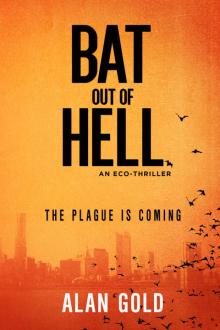Bat out of Hell Read online
Copyright © 2015 by Alan Gold
All rights reserved. No part of this book may be reproduced in any manner without the express written consent of the publisher, except in the case of brief excerpts in critical reviews or articles. All inquiries should be addressed to Yucca Publishing, 307 West 36th Street, 11th Floor, New York, NY 10018.
Yucca Publishing books may be purchased in bulk at special discounts for sales promotion, corporate gifts, fund-raising, or educational purposes. Special editions can also be created to specifications. For details, contact the Special Sales Department, Yucca Publishing, 307 West 36th Street, 11th Floor, New York, NY 10018 or [email protected].
Yucca Publishing® is an imprint of Skyhorse Publishing, Inc.®, a Delaware corporation.
Visit our website at www.yuccapub.com.
10 9 8 7 6 5 4 3 2 1
Library of Congress Cataloging-in-Publication Data is available on file.
Cover design by Karis Drake, Subsiststudios
Print ISBN: 978-1-63158-062-8
Ebook ISBN: 978-1-63158-071-0
Printed in the United States of America
1
ABOVE THE CANOPY OF A JUNGLE IN INDONESIA
There are moments when words fail to define reality. Moments such as when the first Russian soldiers walked into the concentration camps of Nazi Poland and became witness to vast mounds of men, women, and children slaughtered by German industry; moments such as when astronaut John Glenn left the embrace of earth and stepped onto the surface of another world; moments when New Yorkers watched in silence as passenger jets flown by Islamist fanatics deliberately crashed into the twin towers of the World Trade Center, extinguishing three thousand human lives in an instant.
Moments when only thoughts, only the very deepest and most intimate of inexpressible emotions, could encompass the enormity of what the eyes were seeing and rationalize what the mind refused to believe.
Such a moment was now. As the helicopter hovered immobile over the village like a huge mosquito, it searched for a place to set down its passengers without crushing the myriad of dead bodies below. The seven passengers stared down in silence. This was their moment when words, any words of horror, incredulity, or uncertainty, were inadequate to express the fear flooding their minds. Amid all the noise of the helicopter, the passengers were lost in silence . . . introspection . . . searching for meaning in the incomprehensible. Words careened around their minds in an eccentric melange of incoherent thoughts. Yet as the helicopter balanced in the air and dust rings blew in concentric circles from the middle of the village, each passenger forced his or her professionalism to take control, and they became scientists again, able to focus on the immediacy of the task ahead.
Each of the passengers, excluding the pilot, was dressed in a hazmat spacesuit, with two separate and independent supplies of air from the tanks on their backs. Their visors were hermetically sealed against the possibility of external air somehow breaching the seals of the suits that separated the men and women from the outside world.
As soon as they were winched down onto the ground, the helicopter pilot was instructed to leave the area immediately, to return to the ship; then, exactly two hours later, when the scientists’ air supply was three-quarters exhausted, a huge Sikorsky, suspending a large cage, would return for them.
Again, the helicopter would be suspended high above the jungle of Indonesia, they would be hauled sweating and naked into the Sikorsky and would climb into the cage with their samples of body parts, body fluids, and whatever biomass they felt might be pertinent to uncover the mystery. In the cage below the helicopter, they’d dress into paper uniforms and be deposited back on the aircraft carrier, the USS John McCain.
Once on board, they’d be no guard of honor. Instead, they’d take off their paper suits and deposit them into a xenon ultraviolet decontaminator. Stark naked, they would be sprayed with volumes of antiseptic and antimicrobial wash, then scrubbed head to toe by hazmat-suited sailors and jet-sprayed with hot water. Finally, they would be hot-air dried and dressed in forensic overalls. But that was for their return. The hard and hazardous part of the mission over, the men and women of the recovery team would assemble in the aircraft carrier’s laboratory where the real work would begin . . . analyzing the biological samples to try to determine what new and fearsome pathogen had killed the 1,500 villagers of Minangkabau on the Indonesian island of Kasiruta.
The ladder descended until its top was a foot from the ground, a delicate act by the pilot as he used the controls to pirouette at the level of the treetops; the scientists slowly and awkwardly climbed down, reminiscent of the moon landing decades earlier. Once emptied of his passengers, the pilot immediately shifted the controls to vertical take off, not even giving them a traditional wave as he ascended like a bat out of hell to return to the safety of his warship anchored fifty miles off the Indonesian island’s coast.
It took moments for the cacophony of the helicopter to disappear and return the jungle to silence. An odd silence. Most of the scientists had been into the jungle before, and each knew that its characteristic was a perpetual din, an orchestra of insects and animals screeching, howling, screaming, fighting, and mating. During neither night nor day was a jungle silent. Yet through their intercoms, giving their ears a semblance of the outside world, the scientists could hear that in their part of the vast jungle, there was an ungodly silence.
The team leader, Doctor Debra Hart, head of Virus Transmission Analysis at the US Centers for Disease Control and Prevention in Atlanta, realized that her scientists were in alien territory and had to be brought back to their professional present or panic would set in. Alone in an unfamiliar silent world, surrounded by bloated and contorted bodies, some partly eaten by wild animals, some turning a hideous blue-black in the decomposing heat of the jungle, their thoughts had no words to help them understand what had happened. Debra had to put words into action to help them back onto familiar territory.
“Doug, you begin to gather plant samples; Naomi, could you start taking the bloods; Rik, I’d like you to take biopsies of the skin lesions; Jim, could you take tissue samples; the rest of you know what you should be doing. I’ll take an instrumental sweep of the area and collect air, water, and food samples. Jackie, could you help Ivan with the instrument box and begin to unload all the equipment and then you can do stomach samples. Okay, people, let’s move. We’ve got two hours to get our stuff together before we have to get out of here.”
Energized, retreating from panic into the certainty of their training and experience, the scientists set about their assigned tasks. They moved among the dead bodies as though they were negotiating a busy street in New York. No longer were these human beings—men, women, and children who had lived simple lives in an elemental jungle, innocent people whose connection with the outside world had been unwelcome and transitory. Now, right now in the immediacy of an urgent assignment under the aegis of the United Nations and the US government, requested by the government of Indonesia, alarmed by something it couldn’t understand, these scientists were again in the familiar territory of their laboratories, thinking, analyzing, assessing . . . doing.
SIX MONTHS LATER
The audience was in no mood for surprises. The morning had been spent listening to the secretary of Health and Human Services defend her government’s decision to allow local councils to be part of the decision-making process when potentially hazardous experiments involving viruses were undertaken by universities—decisions which had formerly been made by university presidents, boards of regents, and ethics committees. And the audience of leading researchers in the fields of bacteriology, virology, and pathogenic medicine were left angry and contemptuous when the secretary had left the stage with the Parthian shot, �
�Well, if you don’t like what we’re doing, vote us out next election.”
Returning from a lunch of dried out chicken and soggy vegetables, they entered the afternoon session hoping that the next paper would be a meaty bit of science that they could get their teeth into. All in the room either knew Debra Hart or knew of her reputation as a fine scientist and exhilarating national spokesperson for her field of interest. Many of them were excited that such a brilliant and handsome woman would be addressing them for the next hour. Debra had been at the forefront of advancing the fight against the new and dangerous viruses that were gaining a foothold into the developed world, and they knew that because she was a cautious and committed scientist, her talk would be of particular interest to their fields of study. And they’d all read the cover story and seen the painting of her in a recent edition of Time Magazine, calling her the US’s secret weapon in the war against viruses. For the two weeks that it took for the news media to become bored with the story, Debra had been constantly interviewed some time back as a result of the dreadful Ebola epidemic in West Africa that had killed thousands.
Introduced by the provost of Yale who was also dean of medicine at New Haven Hospital, Debra rose to applause and walked confidently to the lectern. But she felt anything but confident. What her audience didn’t realize was that her speech could, probably would, spell the end of her career in public medicine. But it had to be said, and say it she would.
“What I’m going to say will not sit comfortably with many of you. Some may reject my thesis; some may openly criticize me to the media present today. But what I hope is that by my telling you what’s kept me occupied for the past many months, I’ll raise sufficient concern in your minds to encourage some of you in the field of virology to join me in my research.
“This will be the first time you’ve heard of my research because the authorities in Washington have refused me permission to publish what I’m about to tell you. I’m actually breaching a confidentiality and secrecy agreement, so this talk makes me liable to prosecution. But in the name of science, I’ve thought very carefully, and it’s something that I’ve decided that I must do, regardless of the personal consequences to me.
“Which is the reason why I had to pretend that this session was about something relatively innocuous, in order to get out into the public space via the media present today, so that you could be told what’s happening in the world of very nasty viruses.”
The audience of scientists and doctors focused intently on her, a tall and intense young woman, gripping the lectern as though to stop it moving.
“I don’t want to sound overly dramatic, but what I think I’ve discovered could mean that a catastrophic, new, and hideously virulent virus has found its way, as though by magic, across thousands of miles of oceans and land masses, to transmute and become an instant killer. I have no idea what transmission medium the virus used to travel huge distances . . . insects, birds, the wind . . . it’s all conjecture at this stage. But the Ebola virus, colleagues, has left the villages of Africa and Ebola Mark 2, what you might call Ebola on steroids, has found its way into Indonesia. While African Ebola sometimes took a week to kill 60 percent of the people it infected, its evil twin Ebola in Indonesia kills 100 percent within hours. Be afraid, ladies and gentlemen; be very, very afraid.”
She looked up from her paper at the audience in the room but found no satisfaction in the look of amazement on the thousand faces.
***
When the last slide of her PowerPoint presentation was replaced by the conference logo, and she had finished straightening her notes and prepared to step down from the podium, she realized that nobody in the entire audience was applauding. Scientists were far too sophisticated to act like normal people and to cheer and holler after a presentation. The most anybody—Einstein, Newton, Copernicus—should expect from an audience of top-level scientists was mild approbation, even an occasional smile and nod of encouragement from close colleagues. More often, those in the audience whose own research contradicted the speaker’s lecture would shake their heads in dismay and loudly whisper that the speaker’s research was flawed and incorrect.
In surprise, Debra looked up from shuffling her notes and saw that there wasn’t a single movement in the audience. Faces were locked in shock, bodies in paralysis. For the past hour, she’d revealed slide after slide of her expedition to the Indonesian island of Kasiruta, shown them the bodies of the fifteen hundred dead men, women, and children, shown electron-microscopic slide after slide of the virus. shown them planograms of how the virus was thought to have invaded the victims’ neural pathways that lead to the brain, and its rapid overwhelming instructions to close down the infected person’s immune system until death came from the breakdown of capillary blood vessels in the brains of the victims, leading to what must have been unprecedented unbearable headaches, fainting, and death. Other slides had compared the Kasiruta Virus, as she’d dubbed it, to Ebola and other virulent pathogenic viruses.
But when she’d come to the method of transmission from animal to human and human to human, she’d drawn a blank. She’d told them that because of the rapidity of death and decomposition, there was insufficient evidence left on the bodies to determine how they’d caught the virus and how it had spread so quickly from person to person. As a final insult to the scientific method, the Indonesian government had ordered the entire village and surrounding area to be carpet bombed with Napalm, which had burnt over a thousand acres of the surrounding forest. At the end of Debra’s talk, she’d informed her colleagues that, unfortunately, they’d have to await the next outbreak before they could get more evidence.
Gathering her notes, she stepped down from the platform. The emcee stepped up and, in a shaking voice, asked the audience to acknowledge her speech, which was met with halfhearted applause.
THE CONFERENCE COFFEE SHOP
“That was a bold talk. Gutsy. I’m impressed.”
She looked up from her notes into the eyes of a man she’d seen around the conference during the previous two days. He was a fatherly figure, not old enough to be grandfatherly, rugged from long exposure to the outdoors, but the sort who looked more comfortable in slip-ons than lace-ups. He sat, without bothering to ask the traditional “mind if I join you?”
Debra didn’t want her coffee break to be disturbed, especially by someone she’d not met and so presumably didn’t work in her field—someone who would probably prove to be either a fawning fan or a puffed-up antagonist. Whenever she gave a talk, she was often overwhelmed by audience members who wanted to know more; an exhausting hour-long speech often turned into a half-hour longer fanfare with well-wishers wanting to praise or querulous opponents who wanted to air their knowledge. But she’d walked from the hall in the middle of the afternoon sessions and just wanted to be alone to reflect on what she’d said and especially on the audience’s unusual reaction.
And most especially, she needed time to herself to think through the anticipated reaction in Washington tomorrow morning when the newspapers reported her speech. She’d breached her contract of confidentiality, breached undertakings she’d given her boss, breached the trust that hundreds of people had in her, because she was absolutely determined that the public had a right to know, and especially that all scientific information had to be shared if it was to have any peer value.
He sat in a chair next to hers, put his cup of coffee down, and said, “Daniel Todd. Harvard. Associate professor of mammalian biology.”
“What’s a biologist doing at a virology conference?” she asked.
“Trying to get these guys to understand the dangers of bats,” he said, somewhat more phlegmatically than the statement required.
Her interest spiked, she held out her hand, “Debra Hart,” she told him.
He smiled and shook her hand. “I know. I was one of the guys who couldn’t speak after your presentation. You really had the audience by their balls,” he said. “Even the women. You could have heard a pin drop when you were
presenting. I guess I was the only one who knew exactly what you were going to say next,” he told her, sipping his coffee.
“Excuse me?”
“I’ve been waiting for this outbreak for a couple of years now. My only concern is that you’ve wasted six precious months before making the information public. Six months, Debra . . . I could have done a lot in those six months.”
“I don’t know what you mean,” she said. “First off, I’ve had a lock-down notice imposed on me by Health preventing me from publishing anything for fear of causing a public panic. And secondly, this research is absolutely brand new. How could you possibly have known what I was going to say?”
“Because I’m not a virologist. I’m a mammalian biologist. I specialize in the order Chiroptera. Bats. I knew that you were researching something because some suit from the Department of Health in DC came to see me three months ago and asked whether I’d heard of you and knew anything about your research. I told him I didn’t; I asked him what you had to do with bats, and he said ‘nothing.’ Then he asked all sorts of questions about colonies and spread and migration patterns and stuff like that. Never heard from him since. So I put two and two together, read that you were giving a speech, and here we are.”
“Where are we?” she asked, having an uncomfortable feeling about where the conversation was heading.
“I think the vector for your killer bug is bats. I have no idea of the spreading mechanism because bats can’t migrate directly from Africa to the Far East, so the pathogen could have spread in other ways that we need to understand. Or a natural virus in the bat’s blood could have mutated into the Kasiruta virus that killed your village.”
Now that she was no longer a distant figure behind the podium, he looked more closely at her. Divorced twice, he was attracted to women who looked like his former wives, and Debra was unnervingly like a more mature version of his first wife, Dione, who had been a blond-haired blue-eyed beauty making cow eyes at him from the front row of his graduate class when he taught at New York University all those years ago. Debra’s hair wasn’t blond; more a light shade of brown, but her eyes were what attracted him. He’d always been fascinated by women’s eyes, and hers were clear, bright, and wise.

 Birthright
Birthright The Pretender's Lady
The Pretender's Lady The Mechanic
The Mechanic Bloodline
Bloodline Bell of the Desert
Bell of the Desert Bat out of Hell
Bat out of Hell Stateless
Stateless